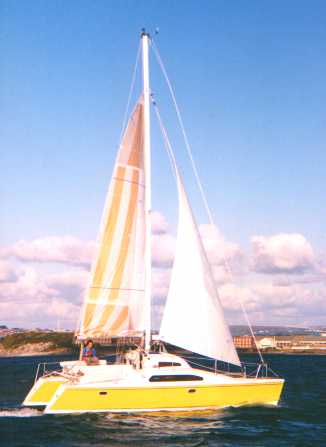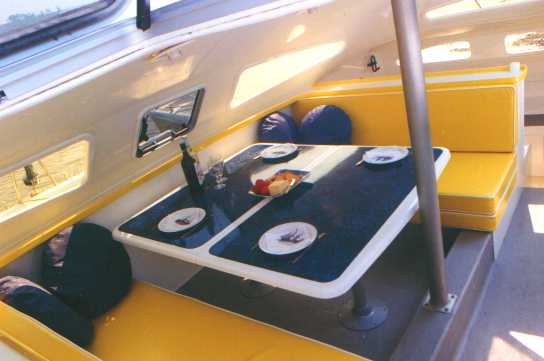From-Multihull International, March 1992
By Geoff Hales

I had the opportunity to sail Sagitta from Plymouth a few days after the Boat Show. So far this boat had sailed from Plymouth and on the Solent and made passages between. Not a huge mileage, but Richard and Lilian are confident that it meets their aims; after a brief showing against the Banshee they are happy that it is indeed a faster boat. While the open bridgedeck versions of this 30ft class are unmistakably Woods' designs and the same shapes can be seen in the hulls of the Sagitta, the bridgedeck accommodation is curvaceous and similar in style to some French designs. Some might argue that it looks something of a hybrid but it is a tribute to their design skills that Richard and Lilian have made the shapes blend together so well and of course the curved coachroof
provides a great deal of strength and extra headroom for very little weight. In return, we discovered, it means that access to and from the mast is tricky once the boat is bouncing at sea, a problem common to all similar coachroofs. You may say that access to the mast shouldn't be required often and it is true that one of the aims of the design was that one could reach and work everything at the foot of the mast from the forward end of the cockpit, but turning blocks are still required and
winches and jammers are still in place on the coachroof itself, so that while the mast is within reach nothing useful seems to have been gained by achieving this. And anyway, however hard you try not to go to the mast, there will always be occasions when you have to get there whether it is for reefing or simply stowing the mainsail. Perhaps the deck arrangements could be made more efficient to make mainsail handling easier.

On Deck
There are deck lockers just forward of the coachroof windows and the whole of the forward part of each hull is also devoted to storage with access only from the deck. Working around the boat proved straightforward with cleats well placed and ample safety precautions. She also proved easy to board which some of the more curvaceous catamarans are not. The cockpit is huge - fully 12ft across and more than 6ft front to back, in fact, it's longer fore and aft than the inside of the saloon coachroof. This is very attractive for entertaining in harbour or taking a very large party sailing in the warm. But otherwise it is larger than could possibly be useful at sea, in fact crossing from one side to the other when tacking caused one to look for something to hold onto while making the long trip across.
The lifting rudder system and the daggerboard arrangements are the same as the Woods have used on earlier designs and proved just as satisfactory and straightforward.
Under Sail
Our sailing opportunity in Plymouth coincided with a southwesterly 25 to 35 knot wind (and sometimes a bit more) which provided good testing conditions to see whether she did indeed slam and how the boat felt in a strong wind and a moderate sea. However, the experience was somewhat spoiled by rigging which had stretched more than could be adjusted so the mast didn't get the support it would like and the jib luff looked horrible. One can only guess what the performance would be like under normal conditions; we all know how expensive headstay sag can be when on the wind. That said, the boat certainly performed very well, she was going up wind with two reefs in the mainsail and a few rolls in the jib at a comfortable 8 knots plus while feeling as though she was not doing any more than 6. The motion was remarkably pleasant, only occasionally was there a sound of a slam underneath and most of the time that seemed to be a wave hitting the inboard side of the lee hull, not the actual bridgedeck slamming at all. There was certainly no discomfort out in the cockpit, nor indeed inside when we tried the saloon for comfort. Some heavy spray came up onto the forward coachroof occasionally but there was no feeling at all that the boat was under any pressure. Helming was a delight partly because the boat handled so very easily and felt responsive without any pressure on the helm and partly because one could sit on a comfortable cushion on a slatted seat and lean against a comfortable backrest with a spray dodger outboard. The view is excellent and you're nowhere near tbe edge of the boat, there is another two feet of hull further outboard again. Richard demonstrated well just how easy sail trimming is, with everything to hand on the coachroof between tbe two saloon doorways. The daggerboards proved equally easy to work from the same place. All the Harken deck gear performed to the expected high standard and tbe Dolphin sails set well.

Under Power
The Woods considered a two engine layout but have settled for one Yamaha 9.9hp electric start 4-stroke outboard which has proved satisfactory with manoeuvering in Port Solent lock proving straightforward. The engine is mounted on a lifting tray in what appears to be the centre of three cockpit lockers and has been fitted with lines to the rudders which successfully assist handling. Certainly it seemed amply powerful and delightfully quiet during our experience.
Accommodation
Tbere are accesses port and starboard to the saloon with a lower washboard in wood and the top half in perspex. This provides a nice arrangement as far as draughtproofing is concerned but it also provides the dilemma of where to stow all the boards when they are not in use. Hinged Bomar hatches are provided to further ease access and increase headroom in the step area.
The interior is unusual by modern yacht standards - there is no varnish to be seen and one is immediately struck by shiny white everything, bulkheads, worktop surfaces and sbelf areas are very high gloss white, very well moulded or painted or panelled. This has been offset by yellow - a yellow edge surround to the worktop areas and all edges of the bulkheads - again very high gloss epoxy coating. Similarly the cushions are yellow, unusual in having covers in pvc rather than a soft but water tolerant polypropylene (= wool lookalike) fabric. Richard and Lilian have used an interior design company, Marine Concepts, to produce three different interiors for the Sagitta. The other two are more traditional.
Predictably tbe saloon seating and table area can convert to a large dinette while the table is the exception to the yellow and white style having a mottled blue and metallic surface. Distinctly hi-tech and unusual for a boat built in Cornwall. Furthermore, tbe table is in two separate pieces, each on a support so that either or both parts can be set up as a cockpit table. The mast support, just abaft the table, acts as a convenient handhold when walking across the saloon, when a slight
crouch is required.
In the aft end of each hull is an amply wide double berth with a curtain across the forward end of it, far enough forward clear of the berth to allow changing room. There is useful locker space outboard, abaft the curtain and forward of the bunk cushions. Forward of the steps down into the starboard hull is the galley area which is extremely roomy and neatly laid out with lockers, drawers and fiddled shelves, some of them using higher spaces which would otherwise be wasted. An eye level oven and grill is an attractive feature set in the forward end of the galley area while a two-burner hob, draining sink and deep sink are outboard On tbe port side, forward of tbe steps down into that hull, there is a small navigation area outboard with a fold-down shelf which could be used as a table in an emergency, but would really be rather inadequate, small and poorly supported for the job It would be much simpler to carry the navigation kit up to the main saloon table and simply use this space a nav gear storage. Forward is a roomy heads compartment with hot and cold water while forward of the heads again is a good, big oilskin drying locker.
Headroom in the hulls is good throughout but the only ventilation comes from small hatches on the outboard sides of the hull which obviously can't be opened if the wind is on that side. In the saloon the forward centre window opens and, of course, the two hatches over the entrances.
An owner who wanted more berths could achieve this by arranging access forward from the heads and the galley to provide a single berth in what is now the forward storage areas in each hull which looked bigger than the boat could ever need.
Conclusion
Overall the Sagitta proved a comfortable boat at sea with an easy motion even in the prevailing lumpy conditions and easily ran up to 14 knots on a reach despite not increasing the sail area once we came off the wind. She tacked positively in the open sea and handled easily under power. The accommodation plan provides exactly what the Woods intended so that altogether she makes a very attractive boat.









